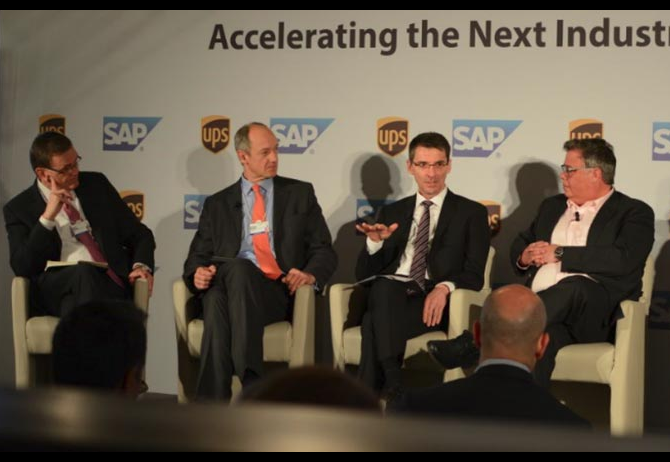
The Future of Digital Economy 7/7
Shaping the Future of Digital Economy and Society
Just like every journey has a destination, every company has a vision. Every journey begins with a single step. Every vision turns into reality with a single decision triggering a single action.
I just returned from the World Economic Forum in Davos, and I’m fueled with many impressions from a forum with over 400 sessions covering everything from the rise of populism to the global economic outlook. Already in focus last year, digitalization continued to be one of the most discussed topics, driving the convergence of technologies that blur the lines between physical, digital and biological systems.
Advancing Innovations for Greater Societal Impact
From the many impressions in Davos, here come my key takeaways:
- Digitalization can help pave the way to a healthier, fairer, and more sustainable world. Our natural resources are limited and digital innovation, for example in the area of 3D printing, have the potential to save lots of energy in the future.
- Artificial intelligence (AI) is changing business and society. I am convinced that machines that become increasingly intelligent can make work easier, but AI can only be a booster of digitalization in a climate of connectivity. Turning this into reality still requires regulatory and legal development – and what is more, we need greater trust in AI and connectivity throughout society and business. Trust is the ultimate currency in the digital economy. We have to have trust in machine learning algorithms that steer business processes – and help people – for more efficiency. This won’t happen by itself: Ethical principles are required to build and maintain trust in digital technologies.
- Knowledge, education, and lifelong learning are key to success. They are the foundation of progress in every area of life, and driven by a natural gift to all of us: curiosity.
During every meeting, every panel, every conversation I had in Davos, concerns and opportunities coming with the digital transformation have been discussed thoroughly, and it became very clear that we need more agile, inclusive, collaborative and comprehensive responses to address the complexity and uncertainty in many areas.
It goes without saying that this will not happen overnight. Davos was a first step, and it is now upon us to continue. We at SAP want to take the right decisions together with our customers, and we take action – for a fair digital economy and thus a better world. The question remains how we can achieve these ambitious goals.
Digital transformation means both a shift in technology and mindset. Consequently, it affects the economy, the society, and every individual. A decade ago, we would not even have begun to imagine the possibilities of what SAP’s software can achieve today.
The Data-Driven Economy
Data – and the value of the data – is a major driving force and key to the digital transformation. Turning raw data into immediate business value ultimately fuels innovation, for example, in the areas of digital customer experience or Internet of Things. Accordingly, data- and digital technology-based innovation is the foundation for future success of companies in the digital economy.
It might sound easy, but the truth is: It is not! The dilemma our customers are facing today is that while they must prepare themselves for the future, they are bound to legacy IT landscapes and the according investments.
Becoming a digital enterprise requires far more than just investing in new technologies. Going forward, every company will have to manage two separate, coherent modes of IT delivery – one focused on stability and the other on agility. There is a need to balance the “never touch a running system” world with the need for agility, flexibility, and speed – by implementing new use cases without disturbing existing processes. Therefore, a separate layer of speed is needed that allows fast innovation, ease of consumption, and a maximum degree of freedom to build individual, differentiating solutions. Gartner calls this “bi-modal IT” where mode 1 represents stability whereas mode 2 stands for agility – as already outlined in my recent blog.
Turning a Vision into Reality
To ensure our development teams are best prepared for supporting our customers in tackling these challenges, we are currently running our annual SAP Development Kick-Off Meetings around the globe. On top of sharing a joint vision, we have also broken down this vision to a rock-solid strategy and top priorities to fulfill the needs of our current and future customers. At the very first meeting in Karlsruhe, Germany, I shared our five top priorities which will guide us through 2017:
- First, there is no doubt that ERP goes cloud. Our answer is SAP S/4HANA Cloud, and we will win the SaaS-ERP market.
- Secondly, we will concentrate on omni-channel e-commerce, redefine the front-office, and focus on next-generation cloud applications.
- Thirdly, our platform-as-a-service offering SAP HANA Cloud Platform will become THE digital platform of choice for developers and customers.
- Fourthly, we will provide a holistic way to manage any volume of data to create a data foundation.
- And last but not least, we innovate for future growth by focusing on strategic drivers like the Internet of Things, Artificial Intelligence, Machine Learning, and Blockchain.
And as you can see, this all sums up to a modular suite for the digital age. We are going through a massive transformation at SAP – with and first and foremost for our customers: We are reinventing our products for the digital age. We are shifting our mindsets and are open to learn and quickly adapt. We allow ourselves to explore and develop new technologies to make our solutions connected and intelligent. That is how we will turn our vision into reality – as every journey begins with a single step.
